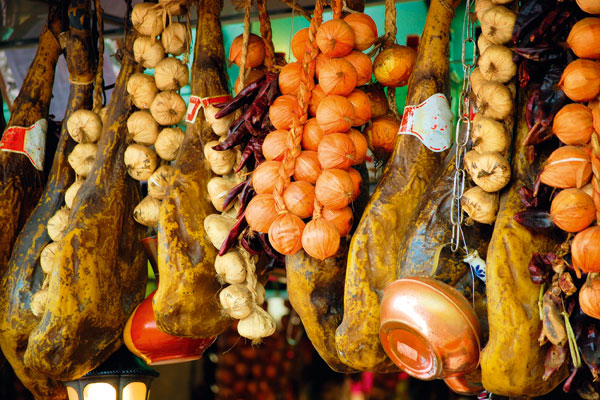On my most recent visit to Seville — the Andalusian city of proverbial fiestas and sunshine — the rain poured for days without stopping. The streets were almost deserted by lunchtime, with tourists taking refuge in the dozens of colourfully tiled tapas bars clustering under the shadow of the cathedral’s soaring bell tower, the Giralda. One day a local friend of mine took me to a newly opened place right in the heart of this district, yet hidden away on a side street, coldly modern in its design, clearly unappealing to tourists, and still barely known to anybody else.
It was called Arenero, and there was just one other couple eating there, who turned out to be the proud parents of the friendly, heavily tattooed young chef. The father made suggestions as to what we should try, and soon we were eating the sort of innovative, exquisitely prepared appetisers that might have transformed this place into a culinary Mecca had it been situated anywhere other than in crisis-worn Seville. But what impressed me more than anything, and made me forget for a moment the rain battering on the large panes of glass, and the pathos of an establishment trying to survive in a Seville where fewer and fewer people can afford to eat out, was a traditional dish of the utmost simplicity: lightly scrambled eggs over porcini mushrooms freshly picked from the nearby woods of the Sierra de Huelva.
Andalusia has always been for me a region of enormous culinary surprises, from the moment of my first extended stay there, nearly 30 years ago, at a time when Spanish food generally was little appreciated abroad, and guidebooks were still repeating the 19th-century adage that Spaniards ate to live rather than lived to eat. Andalusia, as the source of so many clichés about Spain, from bullfighting to flamenco, suffered more than any other region from such culinary prejudices, being maligned even by other Spaniards. A friend from Madrid, on hearing that I was moving for a period down to the south, extolled the beauty of sights such as the Giralda while looking at me almost with pity when it came to the subject of food. I’d be eating, he scornfully predicted, a lot of deep-fried fish.
And to a certain extent he was right, for Andalusia is after all the land whose sherry merchants had reputedly brought to Britain the idea for fish and chips. But I was lucky enough to end up living in Seville in the house of a dynamic and hugely talented cook, Esperanza Flores, who showed me the considerable artistry needed to deep fry with results that were not soggy and greasy but soft and succulent beneath a lightly crisp coating. She also convinced me that Andalusian cuisine, far from being as limited as I had been led to expect, had an exceptional diversity matching that of the region’s landscape.
My culinary education with her was largely conducted in bars, where she claimed the best Andalusian food was usually to be found, often in the dingiest and most unpromising-looking places. Sitting sometimes above floors littered with discarded chicken bones, prawn heads and crumpled paper napkins, I pursued an in-depth study of the Andalusian-born tradition of offering or even automatically giving tapas or snacks every time you ordered a drink. With each new bar, I enjoyed a sense of embarking on a culinary adventure, each drink being accompanied by one of a multitude of potentially outstanding local specialities, such as goat’s cheese, spicy chorizo sausage, pigs’ brains, sweetbreads, salads of orange and salt cod, potatoes sautéed with onions and garlic.
What I learnt above all during these early researches was the depth of passion that even the simplest food seemed to inspire among the Andalusians. ‘There are three things that hold my heart love’s captive’, wrote the 16th-century Sevillian poet Baltasar del Alcázar, ‘the fair Inés, raw ham, and aubergines with cheese’. The pata negra ham of Huelva was one of Esperanza’s own particular obsessions, together with the langoustines of Sanlúcar de Barrameda, and the humble gazpacho — the cold soup that the 19th-century traveller Théophile Gautier thought would have disgusted even his dog, but which Esperanza managed to turn into something truly special by laboriously pounding each of its ingredients in an earthenware bowl, singing all the time as she did so.
Esperanza, who lived life to the full, died too young to witness the dramatic change in reputation that Andalusian cuisine has undergone since the 1990s, brought on by the international craze for tapas bars, the revival of such exotic Hispano-Moorish dishes as aubergines coated in honey, the impact of revolutionary culinary ideas from Catalonia and the Basque country, the ever greater refinement and variety of the region’s olive oils, and the production here in recent years of some of Spain’s finest red wines. However, during that rainy afternoon in the near deserted Arenero, the taste of the porcini induced in me a sudden longing for the little-changed Jaén village where I have been based for the past 12 years, surrounded by people who are convinced that theirs is the best place in Spain to weather out the current crisis. For, as they keep on telling me, life has surely few more satisfying pleasures than getting together with a group of friends to eat goat and garlic sautéed over an open fire. Or drinking wine made from grapes pressed by a neighbour’s feet. Or suddenly coming across, in the middle of the wild mountainous countryside, a handful of edible mushrooms.






Comments